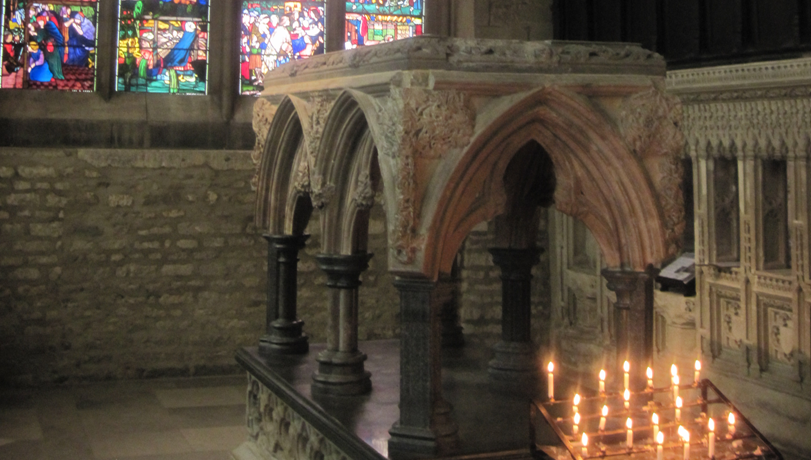 |
| Palm Sunday as represented by Giotto in the Arena Chapel, Padua. |
Christians in Jerusalem before the Edict of Milan (A.D. 315) would not have been able to worship to openly but once Christians were free to worship, a Palm Sunday procession into the gates of Jerusalem, just as Good Friday and Easter were celebrated at Constantine's Church of the Holy Sepulcher, probably started very soon after. St. Cyril of Jerusalem, Bishop there from 349 to 386, is thought to be the writer of these liturgies which also include a foot-washing for Maundy Thursday and the Veneration of the Cross -where a piece of the True Cross was actually venerated.Because of the thousands of pilgrims who were now coming to Jerusalem we are lucky to have a picture of the Holy Week Liturgy there in the 4th century. The account by the Spanish nun, Egeria, on her pilgrimage tells of Cyril's celebration which started on the Mount of Olives and proceeds to the Gates while the people shout "Hosanna in the Highest!"
"Procession with Palms on the Mount of Olives. Accordingly at the seventh hour all the peoplego up to the Mount of Olives, that is, to Eleona, and the bishop with them, to the church, where hymns and antiphons suitable to the day and to the place are said, and lessons in like manner. And when the ninth hour approaches they go up with hymns to the Imbomon, that is, to the place whence the Lord ascended into heaven, and there they sit down, for all the people are always bidden to sit when the bishop is present; the deacons alone always stand. Hymns and antiphons suitable to the day and to the place are said, interspersed with lections and prayers. And as the eleventh hour approaches, the passage from the Gospel is read, where the children, carrying branches and palms, met the Lord, saying; Blessed is He that cometh in the name of the Lord, and the bishop immediately rises, and all the people with him, and they all go on foot from the top of the Mount of Olives, all the people going before him with hymns and antiphons, answering one to another: Blessed is He that cometh in the Name of the Lord. And all the children in the neighbourhood, even those who are too young to walk, are carried by their parents on their shoulders, all of them bearing branches, some of palms and some of olives,2 and thus the bishop is escorted in the same manner as the Lord was of old. For all, even those of rank, both matrons and men, accompany the bishop all the way on foot in this manner, making theseresponses, from the top of the mount to the city, and thence through the whole city to the Anastasis, going very slowly lest the poeple should be wearied; and thus they arrive at the Anastasis at a late hour. And on arriving, although it is late, lucernare takes place, with prayer at the Cross; after which the people are dismissed."
The Palm Sunday Procession seems to have spread quickly as pilgrims who had visited Jerusalem returned home to institute these liturgies in their own Holy-Week rites. The Palm Sunday Procession was incorporated into the Mozarabic Rite of Spain in the 5th century, around the time that Egeria visited the Holy Land, and into the Gallican Rite by the 7th century. And by the 8th century, Palm-Sunday seems to have been a common practice among the Franks in Northern Italy, where it was recorded to be an integral part of the liturgy in the famous Abbey of Bobbio. The well-known hymn: "All Glory, Laud and Honor," was actually a chant written by the 9th century bishop, Theodulf of Orleans:
 |
| Great Lenten Veil at Millstatt Abbey Austria, concealing the high altar. |
The Calvaries of Medieval Brittany and the Palm Sunday Liturgy
 |
| Calvary with a Pulpit at Pleubian. |
 |
| Calvary at St. Jean, Trolimon, Brittany. |
 |
| Calvary at Plugas, Brittany. |
In Britain and Brittany, the graves of the dead were also visited on Palm Sunday and, like the crosses and Calvaries, decorated in Yew branches and flowers (as a replacement for palms). This was symbolic of the hope which Christians hold for the Resurrection of the Dead at Jesus's second coming, -the palms stood for their 'victory' over death just like Christ's victorious entry into Jerusalem was his ride to conquer death. Since very early times, martyrs have also been represented with palm branches as a symbol of their victory. These saints are said to have received the 'Palm of Martyrdom.'
 |
| A procession of virgin martyrs with palms at Ravenna. |

No comments:
Post a Comment